Topics
Category
Era
Minnesota’s Third State Capitol
Minnesota State Capitol, July 22, 2017. Photograph by Wayne Hsieh. CC BY-NC 2.0
On Wabasha Hill, just north of downtown St. Paul, stands Minnesota’s third state capitol building. This active center of state government was built between 1896 and 1905, and was designed by architect Cass Gilbert. Its magnificent architecture, decorative art, and innovative technologies set it apart from every other public building in the state.
The process of building a larger and more fireproof building than the second state capitol started in 1893, when legislators appropriated $2 million for construction and the creation of the Board of State Capitol Commissioners to oversee the project. Due to rising labor costs and materials, and sparing no expense for the interior architectural details and decorative art, they increased that amount two additional times. (The total cost came to nearly $4.5 million when the building opened to the public.)
The board of seven commissioners oversaw every aspect of the work. This included supervising the expenditures, acquiring property, setting building specifications, selecting the architect and general contractor, choosing the type of stone to use on the exterior, and approving the art and artists.
Board members selected Cass Gilbert, a St. Paul architect, to build the new capitol. In addition to creating the overall design, he managed all of the details, selecting the types of stone used, designing furniture for the chambers and public spaces, and working with the artists to determine themes and concepts depicted in the works of art.
Erecting a building of the third capitol’s size and stature was one of the great Minnesota success stories in public architecture and construction. Completed by hundreds of workers, the project was a melding of centuries-old construction techniques with modern building technology. Skilled craftsmen worked alongside steam-powered hoists that lifted stone slabs and iron beams into place. On-site stone carvers used traditional tools but also pneumatic chisels to carve details in the stone. In addition, the building was wired for electricity and had its own power plant.
As innovative as the technology was, it was overshadowed by the grandeur of the interior spaces. The rotunda’s 142-foot-high soaring dome, with its six-foot wide, ninety-two-light-bulb chandelier, amazed viewers. Workers used stone from Minnesota and other parts of the US, Europe, and Africa in every chamber and public space, including an inlaid north star in the rotunda. Coupled with the architectural elements were works of art from some of America’s most well-known artists. The murals and paintings, which featured allegories and historical events, were intended to promote the virtues of good government and the story of the state’s history, progress, and prosperity at the turn of the twentieth century.
This theme carried over to the iconic gold-leafed quadriga located on the roof above the main entrance. Its official title, “Progress of the State,” represents the state’s prosperity. It was installed in 1906, nearly one year after the capitol opened.
The new building accommodated most of the state government. The state supreme court, both legislative bodies, and all executive offices made the building their new home, along with state agencies, commissions, and the Minnesota Historical Society.
As the state government expanded, space limitations were an ongoing issue. From the 1930s until the 1960s, some of the executive offices and various agencies moved to other buildings built on the capitol complex. Even up to the 1980s, because of space constraints, the ground floor had temporary walls and partitions installed to provide work space for office staff.
Work to restore parts of the capitol to their original appearance began in 1985 with the governor’s reception room. That was followed by the Senate chamber (1988), the House of Representatives’ chamber (1989), the quadriga (1994), the Rathskeller (1999) and the third-floor ceiling (2007).
After a century of use by all three branches of state government and visits by millions of people, repairing the building became a focal point. Between 2013 and 2017, the capitol underwent a comprehensive repair and restoration. Guided by three key principles— historical integrity, life safety, and modern functionality—this undertaking was allocated $310 million from the state legislature to do the necessary work. This included cleaning and replacing deteriorating Georgia marble on the exterior and replacing the roof.
Other work included installing new mechanical and electrical systems, egress staircases, and an elevator. Conservators restored the fine art and repainted the decorative walls and ceilings to match the original 1905 colors and designs. In addition, the removal of office spaces on the third floor and mechanical and storage spaces in the basement opened up new public gathering spaces, meeting rooms, and exhibit areas.
- Length: 434 feet, excluding steps
- Width: 220 feet, excluding steps
- Height of dome from ground: 223 feet
- Height of dome interior (rotunda): 142 feet
Bibliography
Board of State Capitol Commissioners records, 1892–1914
State Archives Collection, Minnesota Historical Society, St. Paul
Description: Biennial reports, minutes, photographs, correspondence, financial records, bids and contracts, printed materials, and miscellany relating to construction of the Minnesota State Capitol Building.
http://www2.mnhs.org/library/findaids/gr01252.xml
119.C.4.5.B
Bureau of Labor Statistics Biennial Reports, 1888–1930
Minnesota Labor and Industry Department
State Archives, Minnesota Historical Society, St. Paul
Description: The 1903–04 report has detailed information on Minnesota accidents and strikes.
A/+G464
Cass Gilbert papers, 1882–1934 (bulk 1882–1910)
Manuscripts Collection, Minnesota Historical Society, St. Paul
Description: Correspondence, contracts, agreements, specifications, sketches, and other materials relating chiefly to buildings designed by Gilbert, an architect who opened offices in St. Paul, Minnesota (1882) and New York City (1899). About one-third relate to the design and construction of the Minnesota State Capitol (1893–1909).
Gardner, Denis. “The Minnesota State Capitol: A 1905 Masterpiece Restored to its Original Grandeur.” Minnesota History 65, no. 4 (Winter 2016–2017), 136–141.
http://collections.mnhs.org/mnhistorymagazine/articles/65/v65i04p136-141.pdf
——— . Our Minnesota State Capitol: From Groundbreaking Through Restoration. St. Paul: Minnesota Historical Society Press, 2017.
Minnesota Board of State Capitol Commissioners. “Biennial Report of the Board of State Capitol Commissioners, Appointed to Construct a New Capitol for the State of Minnesota,1895–1907.” Available at the Minnesota Historical Society library as F613.S82 M55a.
Minnesota Historical Society. Minnesota State Capitol.
http://www.mnhs.org/capitol
O'Sullivan, Thomas. North Star Statehouse: An Armchair Guide to the Minnesota State Capitol. [St. Paul]: Pogo Press, 1994.
Thompson, Neil B. Minnesota’s State Capitol: The Art and Politics of a Public Building. St. Paul: Minnesota Historical Society Press, 2005.
“Who Built Our Capitol?” Oral history interview with Ginny Lackovic, HGA architect, conducted by Randy Croce, November 2010.
https://whobuiltourcapitol.advantagelabs.com/articles/ginny-lackovic-architect-interview
Who Built Our Capitol?
https://www.whobuiltourcapitol.org
Related Resources
Primary
PR 21
Carsley, George H. "Daily Memorandum" and "Minnesota State Capitol Report"
Cass Gilbert Collection, 1883–1952
Department of Prints, Photographs, and Architectural Collections
New-York Historical Society, New York
Description: Correspondence between capitol architect Cass Gilbert in New York and assistant George Carsley at the capitol site in St. Paul.
http://dlib.nyu.edu/findingaids/html/nyhs/Gilbert
+Reserve 47 Box 1, July 1900
Records, 1892–1914
Board of State Capitol Commissioners
Photograph Collection, Minnesota Historical Society, St. Paul
http://www2.mnhs.org/library/findaids/gr01252/pdfa/gr01252-00001.pdf
Description: Photograph album of state capitol construction images, 1896–1905, including workers, equipment, and machinery. All phases of construction work are shown, including worker conditions, tools used, materials used, and machinery, such as steam-powered hoists and derricks. Also includes a view of the stone mill and workshops located around the construction site. Photographers: Haas & Wright.
Secondary
Pearson, Marjorie. “Approaching the Capitol: The Story of the Minnesota State Capitol Mall.” Minnesota History 65, no. 4 (Winter 2016–2017): 120–135.
http://collections.mnhs.org/mnhistorymagazine/articles/65/v65i04p120-135.pdf
Roethke, Leigh. Minnesota's Capitol: A Centennial Story. Afton, MN: Afton Historical Society Press, 2005.
Related Video
Minnesota State Capitol, Then and Now
All rights reserved
Holding Location
More Information
Articles
Related Images
Minnesota State Capitol, July 22, 2017. Photograph by Wayne Hsieh. CC BY-NC 2.0
The Rathskeller (eating area) in the basement of the Minnesota State Capitol. Photograph by Alan Cordova, October 3, 2014. CC BY-NC-ND 2.0
The governor’s reception room inside the Minnesota State Capitol in St. Paul. Photograph by Wayne Hsieh, July 22, 2017. CC BY-NC 2.0
The interior of the dome of the Minnesota State Capitol. Photograph by Wayne Hsieh, July 22, 2017. CC BY-NC 2.0
The meeting place of the Minnesota Supreme Court inside the Minnesota State Capitol. Photograph by Wayne Hsieh, July 22, 2017. CC BY-NC 2.0
The meeting place of the Minnesota Senate inside the Minnesota State Capitol. Photograph by Wayne Hsieh, July 22, 2017. CC BY-NC 2.0
The meeting place of the Minnesota House of Representatives inside the Minnesota State Capitol. Photograph by Wayne Hsieh, July 22, 2017. CC BY-NC 2.0
Minnesota State Capitol, September 8, 2017. Photograph by Wikimedia Commons user McGhiever. CC BY-SA 4.0.
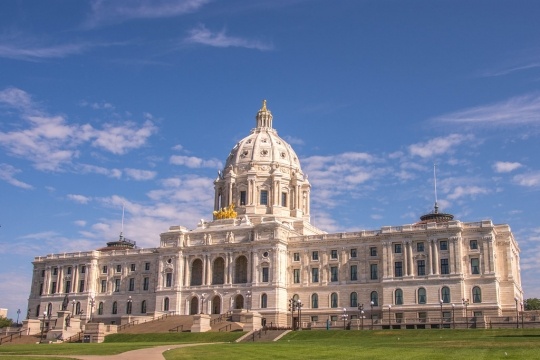
Minnesota State Capitol
Minnesota State Capitol, July 22, 2017. Photograph by Wayne Hsieh. CC BY-NC 2.0
Holding Location
Articles
More Information
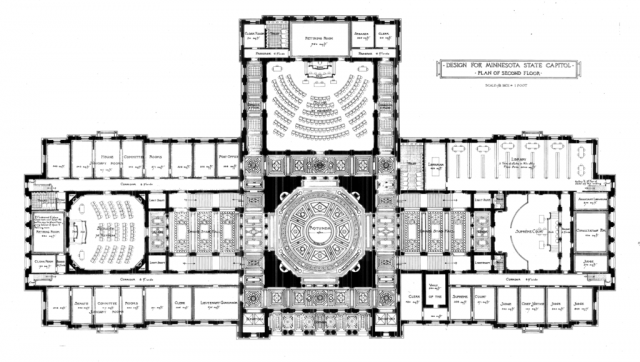
Second-floor plan
Holding Location
Articles
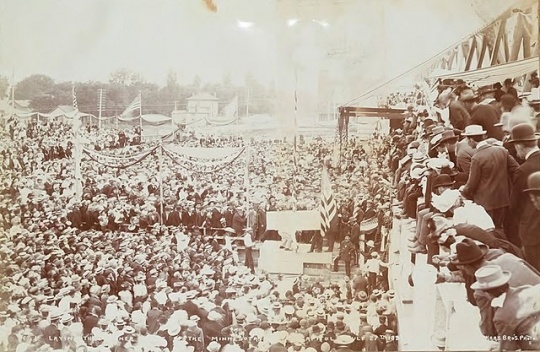
Laying the cornerstone
Holding Location
Articles
More Information
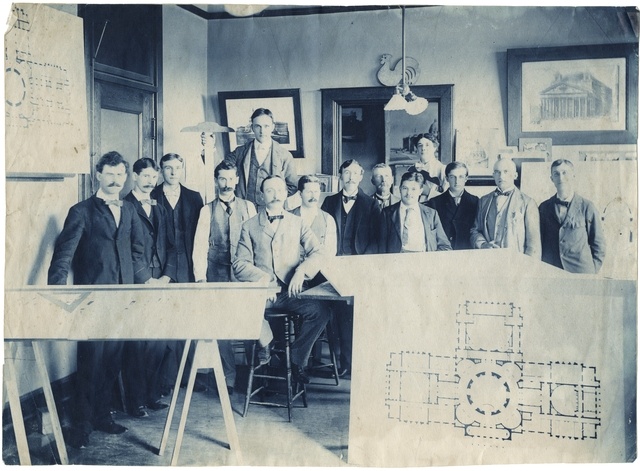
Cass Gilbert and staff
Holding Location
Articles
More Information
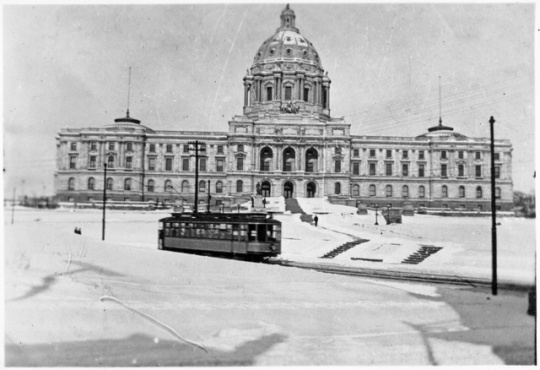
Minnesota State Capitol ca. 1913
Holding Location
Articles
More Information
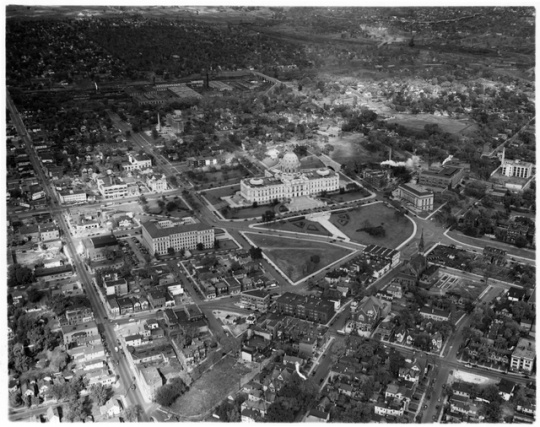
Aerial view of Minnesota State Capitol
Holding Location
Articles
More Information
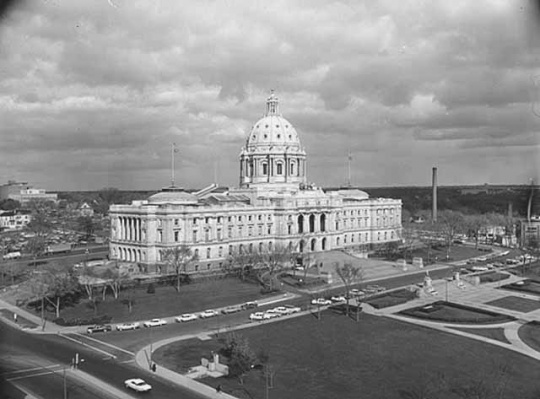
Minnesota State Capitol in 1963
Holding Location
Articles
More Information
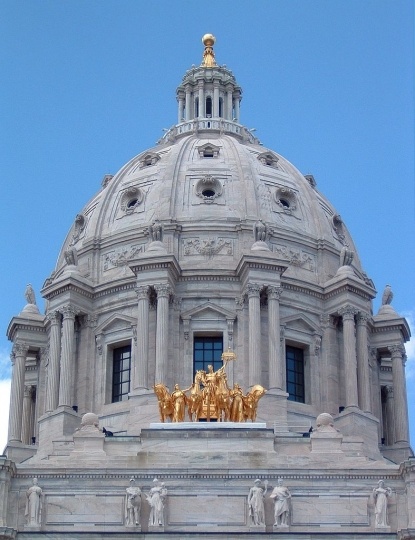
Minnesota State Capitol dome
The dome of the Minnesota State Capitol and the quadriga sculpture, "The Progress of the State." Photograph by Wikimedia Commons user Mulad, July 6, 2005. Public domain.
Public domain
Holding Location
Articles
More Information
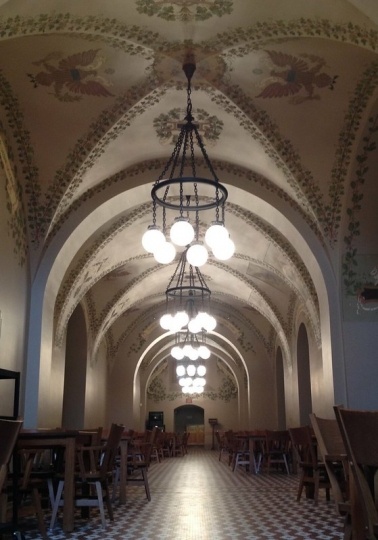
Rathskeller
The Rathskeller (eating area) in the basement of the Minnesota State Capitol. Photograph by Alan Cordova, October 3, 2014. CC BY-NC-ND 2.0
Holding Location
Articles
More Information
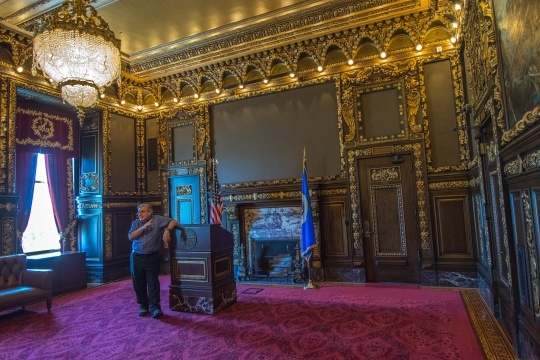
Governor’s reception room
The governor’s reception room inside the Minnesota State Capitol in St. Paul. Photograph by Wayne Hsieh, July 22, 2017. CC BY-NC 2.0
Holding Location
Articles
More Information
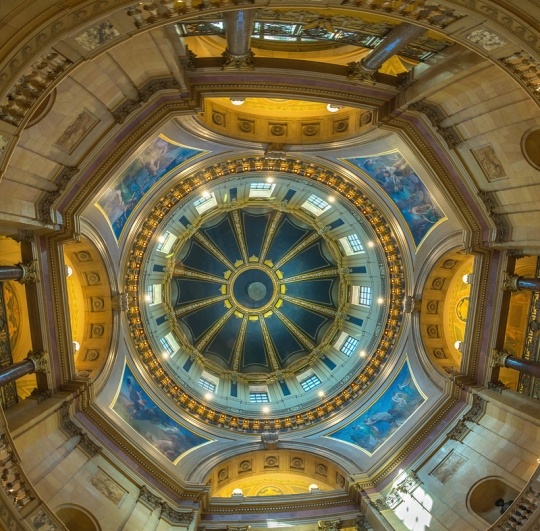
Dome interior
The interior of the dome of the Minnesota State Capitol. Photograph by Wayne Hsieh, July 22, 2017. CC BY-NC 2.0
Holding Location
Articles
More Information

Minnesota Supreme Court chamber
The meeting place of the Minnesota Supreme Court inside the Minnesota State Capitol. Photograph by Wayne Hsieh, July 22, 2017. CC BY-NC 2.0
Holding Location
Articles
More Information
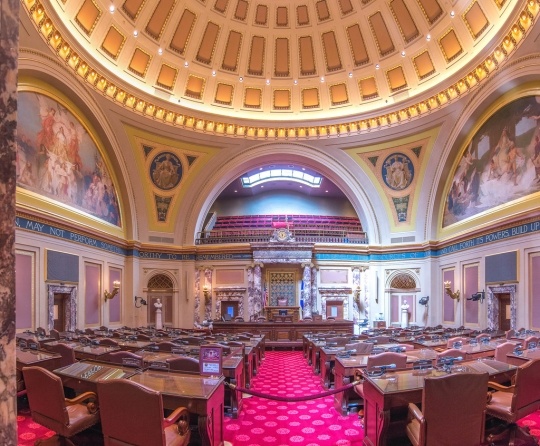
Minnesota Senate chamber
The meeting place of the Minnesota Senate inside the Minnesota State Capitol. Photograph by Wayne Hsieh, July 22, 2017. CC BY-NC 2.0
Holding Location
Articles
More Information
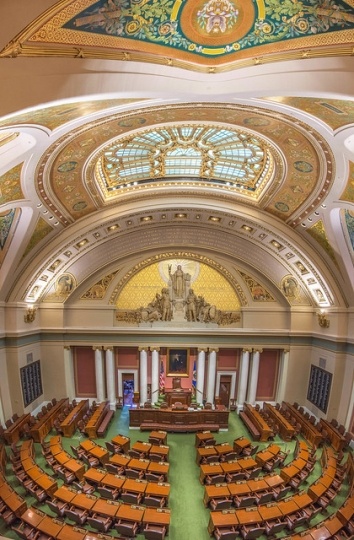
Minnesota House chamber
The meeting place of the Minnesota House of Representatives inside the Minnesota State Capitol. Photograph by Wayne Hsieh, July 22, 2017. CC BY-NC 2.0
Holding Location
Articles
More Information
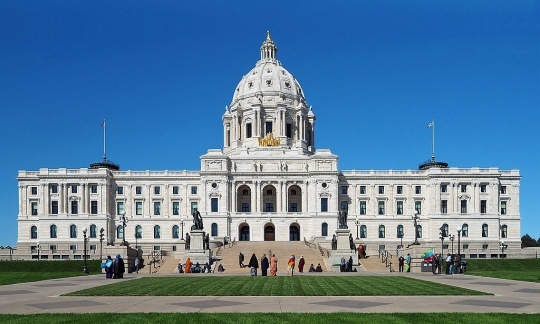
Minnesota State Capitol
Minnesota State Capitol, September 8, 2017. Photograph by Wikimedia Commons user McGhiever. CC BY-SA 4.0.
Holding Location
Related Articles
Turning Point
On April 1, 1903, the Minnesota legislature approves the request of Cass Gilbert (via the Board of State Capitol Commissioners) for $1.5 million in additional funding to complete the capitol. This final appropriation makes it possible to install custom-made furniture and works of art throughout the building.
Chronology
1893
1895
1896
1898
1899
1902
1905
1907
1918
1985
1994
2005
2013–2017
Bibliography
Board of State Capitol Commissioners records, 1892–1914
State Archives Collection, Minnesota Historical Society, St. Paul
Description: Biennial reports, minutes, photographs, correspondence, financial records, bids and contracts, printed materials, and miscellany relating to construction of the Minnesota State Capitol Building.
http://www2.mnhs.org/library/findaids/gr01252.xml
119.C.4.5.B
Bureau of Labor Statistics Biennial Reports, 1888–1930
Minnesota Labor and Industry Department
State Archives, Minnesota Historical Society, St. Paul
Description: The 1903–04 report has detailed information on Minnesota accidents and strikes.
A/+G464
Cass Gilbert papers, 1882–1934 (bulk 1882–1910)
Manuscripts Collection, Minnesota Historical Society, St. Paul
Description: Correspondence, contracts, agreements, specifications, sketches, and other materials relating chiefly to buildings designed by Gilbert, an architect who opened offices in St. Paul, Minnesota (1882) and New York City (1899). About one-third relate to the design and construction of the Minnesota State Capitol (1893–1909).
Gardner, Denis. “The Minnesota State Capitol: A 1905 Masterpiece Restored to its Original Grandeur.” Minnesota History 65, no. 4 (Winter 2016–2017), 136–141.
http://collections.mnhs.org/mnhistorymagazine/articles/65/v65i04p136-141.pdf
——— . Our Minnesota State Capitol: From Groundbreaking Through Restoration. St. Paul: Minnesota Historical Society Press, 2017.
Minnesota Board of State Capitol Commissioners. “Biennial Report of the Board of State Capitol Commissioners, Appointed to Construct a New Capitol for the State of Minnesota,1895–1907.” Available at the Minnesota Historical Society library as F613.S82 M55a.
Minnesota Historical Society. Minnesota State Capitol.
http://www.mnhs.org/capitol
O'Sullivan, Thomas. North Star Statehouse: An Armchair Guide to the Minnesota State Capitol. [St. Paul]: Pogo Press, 1994.
Thompson, Neil B. Minnesota’s State Capitol: The Art and Politics of a Public Building. St. Paul: Minnesota Historical Society Press, 2005.
“Who Built Our Capitol?” Oral history interview with Ginny Lackovic, HGA architect, conducted by Randy Croce, November 2010.
https://whobuiltourcapitol.advantagelabs.com/articles/ginny-lackovic-architect-interview
Who Built Our Capitol?
https://www.whobuiltourcapitol.org
Related Resources
Primary
PR 21
Carsley, George H. "Daily Memorandum" and "Minnesota State Capitol Report"
Cass Gilbert Collection, 1883–1952
Department of Prints, Photographs, and Architectural Collections
New-York Historical Society, New York
Description: Correspondence between capitol architect Cass Gilbert in New York and assistant George Carsley at the capitol site in St. Paul.
http://dlib.nyu.edu/findingaids/html/nyhs/Gilbert
+Reserve 47 Box 1, July 1900
Records, 1892–1914
Board of State Capitol Commissioners
Photograph Collection, Minnesota Historical Society, St. Paul
http://www2.mnhs.org/library/findaids/gr01252/pdfa/gr01252-00001.pdf
Description: Photograph album of state capitol construction images, 1896–1905, including workers, equipment, and machinery. All phases of construction work are shown, including worker conditions, tools used, materials used, and machinery, such as steam-powered hoists and derricks. Also includes a view of the stone mill and workshops located around the construction site. Photographers: Haas & Wright.
Secondary
Pearson, Marjorie. “Approaching the Capitol: The Story of the Minnesota State Capitol Mall.” Minnesota History 65, no. 4 (Winter 2016–2017): 120–135.
http://collections.mnhs.org/mnhistorymagazine/articles/65/v65i04p120-135.pdf
Roethke, Leigh. Minnesota's Capitol: A Centennial Story. Afton, MN: Afton Historical Society Press, 2005.

















